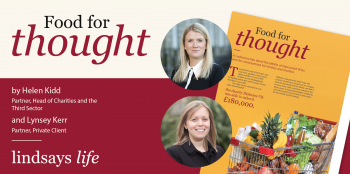Inheritance Tax (IHT) is one of the most hated taxes on estates by families. Often referred to as the ‘death tax’, it is one which HMRC have greatly benefitted from for many years. However, for the first time in ten years, HMRC have reported a decrease in the amount of IHT receipts that they have received. It is thought that this is largely down to the introduction of the new Residence Nil Rate Band in 2017. But what exactly are these taxes and what do they mean in terms of your estate?
When is IHT payable?
IHT is a tax which is paid to HMRC upon an individual’s estate when they die. The current tax-free threshold (known as the “Nil Rate Band” or “NRB”) for individuals is £325,000 and any amount above this will be taxed at 40%. It must be paid within 6 months of the date that the individual died and any tax due will be paid from the individual’s estate.
However, if the individual made significant ‘gifts’ within seven years of their death, IHT may be due upon these gifts too. Such ‘gifts’ would include any cash or specific assets of high monetary value gifted to relatives, normally for much less than their full market value. If tax is due upon such gifts, it will be the responsibility of the individual who received the gift to pay their share of the tax.
One exemption to the general rule is transfers between spouses and civil partners. The position here is that any assets which are transferred between spouses or civil partners will be exempt from paying IHT. Therefore, if you leave your estate to your spouse or civil partner, there will be no IHT to pay upon first death.
An individual’s unused IHT threshold can be transferred to a surviving spouse or civil partner’s estate and this is known as a Transferrable Nil Rate Band (TNRB). This means that the estate of a surviving spouse or civil partner can utilise the unused Nil Rate Band of the first spouse or civil partner to pass away, in addition to using their own. For couples, this provides a maximum tax-free threshold of £650,000.
An additional tax-free threshold – Residence Nil Rate Band
The Residence Nil Rate Band (RNRB) was a welcomed additional tax-free threshold introduced in 2017. This provides that where an individual has passed away and left a property, or the sale proceeds from a property, to their ‘direct descendants’, an additional IHT band is available to the estate.
The guidance defines ‘direct descendants’ as children (or grandchildren or other lineal descendant) including step-children, fostered children, those for whom the deceased was appointed as Guardian and children who are adopted. Spouses and civil partners of lineal descendants also fall into this group. The current RNRB is £175,000 and, similar to the IHT Nil Rate Band, Residence Nil Rate Bands can be transferred between spouses and civil partners.
With the ability to utilise and transfer both the Inheritance Tax Nil Rate Band and the Residence Nil Rate Band, the maximum tax-free threshold for a couple is currently £1 million.
In the 2017/18 tax year, the first tax year in which the RNRB became available, HMRC reported that 20,200 estates used the RNRB threshold. This allowed £3.1 billion of IHT to be saved. HMRC confirmed that this was the main cause of the reduction in Inheritance Tax.
Investigating estates
Although the amount of IHT paid to HMRC has decreased for the first time in years, HMRC have reported that their investigations into estates for IHT have increased, as well as their earnings from such investigations.
In a recent Freedom of Information Report, HMRC revealed that they received £247 million worth of additional Inheritance Tax from 5000 investigations during the 2019/20 tax year. It has also been reported that HMRC have increased the amount of investigations carried out since the introduction of the RNRB.
HMRC have the ability to open investigations at random and do so to ensure that Executors are declaring all details of an individual’s estate. With this in mind, it is so important to understand the tax position of an estate and the implications of not paying the correct amount of tax.
When dealing with an estate, Executors are currently legally bound to complete a declaration for HMRC detailing the tax position of the estate. If HMRC open an investigation, the Executors of the estate must not distribute any assets until the tax position has been confirmed and cleared by HMRC. If an Executor does distribute the deceased’s estate whilst an investigation is ongoing, the Executor may be held personally liable for any additional tax that may be due. It is further recommended that Executors keep hold of all tax paperwork and details as HMRC can ask to see these documents up to 20 years after IHT has been paid.
The tax position on estates is often a complex matter and it is thought that many individuals do not fully understand the position. It is always worth seeking advice from a solicitor when winding up an estate to ensure that HMRC’s requirements are met. If this is something that you would like assistance with, our Private Client team would be more than happy to help.






